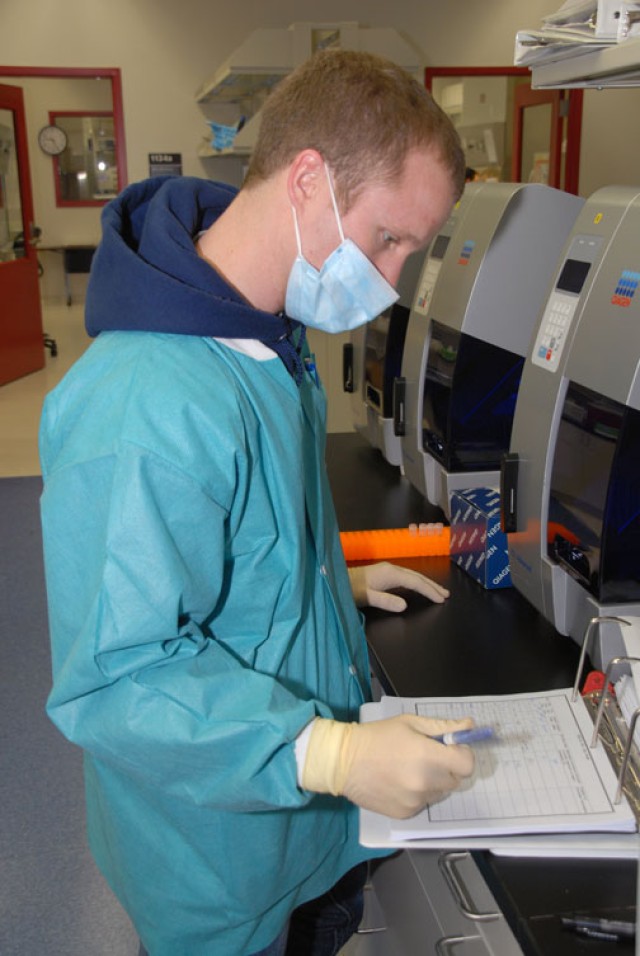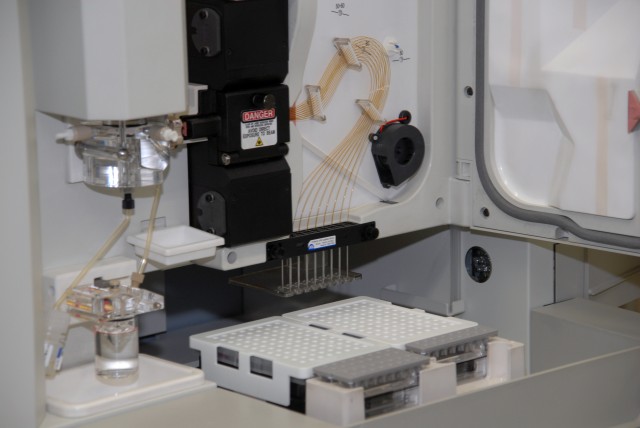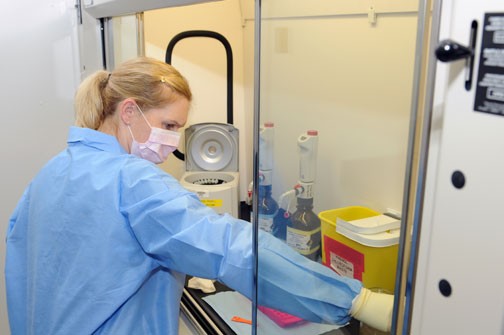DNA-three small letters that have drastically changed the world and forever altered how crimes are investigated and prosecuted.
'More formally known as deoxyribonucleic acid, DNA contains the genetic makeup of every living organism and is unique to each individual, except in the case of identical twins. DNA collected from a crime scene can be compared against a suspect's to prove whether or not he was present at the scene.
'The DNA Branch at the U.S. Army Criminal Investigation Laboratory, Fort Gillem, Ga., which serves all branches of the Department of Defense, has recently doubled in size. About 50 examiners at the lab process around 90-95 cases a month, mostly looking at blood, semen and saliva, although they also have the capability to examine tissue, urine and hair.
'In the past two decades, DNA techniques have become so sensitive and advanced that examiners can often obtain usable DNA samples by testing places a suspect or victim merely touched. If a suspect grabs a victim's lapels, for example, examiners may be able to obtain DNA from those lapels.
'In addition, chief DNA examiner Jeffrey 'Fletch' Fletcher can lift DNA from the underarms or collar of a seemingly unstained shirt, and has been able to identify, or clear, alleged sex offenders based on touch DNA on victims' bra cups. He has also found the DNA of victims on the inside of suspects' underwear.
'You'd be amazed what we can get DNA from,' said Fletcher. In fact, the DNA replication, extraction and comparison process has become so streamlined that a sample as small as a pencil point can be processed in a matter of days. The hardest part is finding the DNA to test.
'When we're talking about doing a sexual assault examination-and let's say it has multiple suspects, and let's say the bedding has not been laundered in quite some time...you're looking at maybe a comforter or a sheet that has 80-plus stains, and...you have to almost test them all,' Fletcher explained, adding that when he worked for a state crime lab, he couldn't spend weeks pouring over evidence the way he does at USACIL.
'What I like about CID and the military is, 'do what has to be done.' If it takes a little longer to get a case done, we want to get it done the first time. We're a little more thorough in our analysis in the sense that we would examine evidence that maybe in a state lab wouldn't be probative. From this aspect, we're able to look at everything,' he continued.
'In order for a DNA sample to do investigators and prosecutors any good, however, it must be compared against a "known standard," in other words, a sample taken from a suspect or victim. Once the two samples have been processed, a computer printout lists the number of times each particular code repeats itself, and the examiner compares the two.
'Although 99.7 percent of DNA is the same for everyone, according to Fletcher, certain regions on the DNA strand vary greatly. Examiners look at about 15 of those regions, and can say with certainty if two DNA samples came from the same person, and add a statistical weight. Fletcher said this is where experts come up with numbers like a one-in-50-billion chance of the sample occurring naturally in a different person. Since there are far less than 50 billion people on earth, it's an identity statement. All it says, however, is that a suspect was at a crime scene or came in contact with a victim, it doesn't say why or how. Those questions are left for investigators to answer.
'Lab workers also upload samples from suspected criminals to the Combined DNA Indexing System, a database of DNA designed and maintained by the FBI. Crime labs nationwide use the system as a way to identify an unknown sample, if a potential criminal has offended before and is in the database, or to link cases. For example, a sample uploaded at USACIL might match a sample uploaded by a Florida crime lab.
'That way we can coordinate with one another to generate investigative leads that help solve crimes,' said Mike Mann, a CODIS technician at USACIL.
'And while DNA may have revolutionized the way crimes are solved, to the extent that investigators and forensic scientists moan that juries expect DNA in every case and discount other evidence, new research is about to revolutionize DNA itself.
'According to Jeff Salyards, the director of science and technology (i.e. research and development) at USACIL, the Army and DOD have partnered with the Departments of Homeland Security, Justice and State, as well as private labs, on a "DNA-on-a-chip" project using microfluidics and nanotechnology. It promises to drastically increase the number of samples that can be run at once, and decrease the time it takes to do so.
'The way we do DNA right now is with something called PCR: polymerase chain reaction,' Salyards said. 'Even if you just have a tiny, tiny bit of DNA, it's OK, because we make copies of the DNA. In order to do that, we need to heat it up and cool it down. One of the advantages of (using microfluidics), is that the material flows through something that's skinnier than a hair-this little tiny microfluidic chamber. You can heat this chip up with 16 of those lanes in there and cool it down much faster than a plastic tube.
'Instead of taking hours, maybe even a couple days, it takes minutes. In a rush DNA job right now, we can probably do it in two or three days. This thing will take 45 minutes to do 16 samples. So that's a pretty exciting project,' Salyards explained.
The first operational prototype should be available this summer. While it could experience issues initially, as with many prototypes, he believes it will eventually work and that the future will take forensic science beyond DNA.
'I suspect in 15 years...I'll be gray-haired with my walker and we'll have a beer joking about 'Remember when we used to do DNA'' I think it will be something like that,' Salyards said. There are some possible replacement molecules. One of them, related to DNA, is something called RNA. Your DNA is a sort of recipe for how to make protein in your body and there's an intermediate step that...reads the DNA and then it goes out and makes the proteins.
'As a result, there's a lot more RNA floating around in your cells. There's one copy of DNA and all kinds of chunks of RNA because your body's constantly making these proteins. It may be that those would survive longer in degraded samples. It may be that there's a whole branch of biochemistry that we just don't understand well enough, that we might find some other marker that's equally variable, equally unique, that's maybe easier to test, that goes even faster.'










Social Sharing